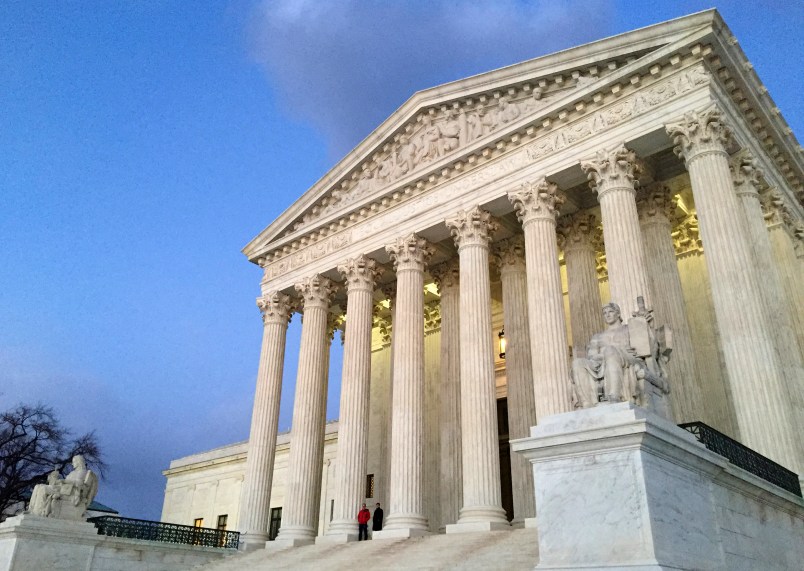WASHINGTON (AP) — A seemingly divided Supreme Court debated Tuesday whether to strike down a Wisconsin redistricting plan because it is too partisan, in a case that could affect elections across the country.
The big question, after an hour-long argument, is whether Justice Anthony Kennedy, whose vote appears to control the outcome, is ready for the first time to rule that electoral maps are so favorable to one party that they violate the constitutional rights of the other’s voters.
Kennedy suggested, as he did in another redistricting case 13 years ago, that courts perhaps could be involved in placing limits on extremely partisan electoral maps.
But he did not tip his hand at all about whether the Wisconsin map that favors Republicans crossed a constitutional line.
The Supreme Court has never thrown out a political map because it is too partisan. Courts have struck down districts as racially biased for decades, and other partisan districting lawsuits are moving through the courts in Maryland and North Carolina.
There was little doubt about the other justices’ views.
The liberal justices appeared to favor the Democratic voters who challenged the Wisconsin plan. Republicans who controlled the legislature and the governor’s office adopted electoral maps that have given them a significant advantage in the state Assembly in a state that is otherwise roughly divided between the parties.
Justice Ruth Bader Ginsburg said that a decision upholding the Republican-drawn districts in Wisconsin would encourage one party’s lawmakers to stack the deck against their opponents when they control the process and reduce the number of legitimately contested elections.
“What becomes of the precious right to vote?” she asked.
The conservative justices were skeptical about striking down the state’s map or even involving courts in the inherently political process of redistricting.
Chief Justice John Roberts worried about involving the Supreme Court in a glut of partisan redistricting claims that would follow if the Wisconsin Democrats prevail.
“We’ll have to decide in every case whether the Democrats win or the Republicans win,” Roberts said, a scenario that he said would damage the court’s credibility.
Throughout the session, the justices and lawyers alike appeared to cast their questions and remarks for the benefit of only member of the court whose vote seems unclear, Kennedy.
He wrote in 2004 that he had yet to be shown a good way to measure and manage excessively partisan districts.
“If workable standards do emerge to measure these burdens, however, courts should be prepared to order relief,” Kennedy wrote in a redistricting case from Pennsylvania, Vieth v. Jubilirer.
Paul Smith, the same lawyer who failed to get Kennedy’s vote and thus a majority 13 years ago, said technology and data analysis had so improved since then that there are good ways to measure when one party gives itself an unfair edge in creating districts.
Without the court’s intervention, Smith said on behalf of the Democratic voters, the next round of redistricting after the 2020 census will see far more extreme partisan maps.
“You are the only institution in the United States that can solve this problem just as democracy is about to get worse,” Smith said.
“You paint a very dire picture,” Justice Samuel Alito replied dryly. He seemed unpersuaded.
Representing Wisconsin, Misha Tseytlin urged the court not to succumb to the other side’s “scare tactics about what will happen next.”
In Wisconsin, a lower court sifted through evidence showing that Republicans packed Democrats into some districts and spread them out across others to maximize gains for the GOP. In one analysis, Democrats captured far fewer state Assembly seats even when they won roughly the same percentage of the statewide vote as Republicans.
The lower court concluded that the districting plans were drawn to discriminate against Democrats, the Republicans’ advantage would endure even in the face of a strong Democratic showing at the polls and the plans could not be explained by other, non-partisan reasons.
The state is arguing the justices should put an end to courts’ consideration of partisanship in districting plans and cautioning that far from being manageable, a ruling for the Democratic voters would open the door to a flood of lawsuits that would be based on cherry-picked evidence and hard for judges to manage.







This is the most important case before the SC in a very long time. Gerrymandering is so obviously a form of cheating and should be made illegal.
Why do we even bother with the hearings and pretending there’s going to be any justice here?
Just skip to the announcement late next spring that-- spoiler alert-- it comes to a 5-4 decision in favor of the Republicans.
The Supreme Court is a farce.
This is almost certainly the most important case the court will consider this year. It goes to the heart of democracy, and democracy is–or should be–the heart of the nation.
Gerrymandering and Citizens United are like two fat ladies singing as the curtain falls on the democratic opera called America.
The court is not really a farce. We hear about the cases where the court is divided on what seem to be partisan lines, but in most cases, that’s not so. And there have been times in the past–and there will be again in the future–when justices have grown from their experiences and broken new ground Harry Blackmun, appointed by Nixon, wrote the majority decision in Roe v. Wade. Souter, appointed by Bush I, became a pretty reliable “progressive” justice.